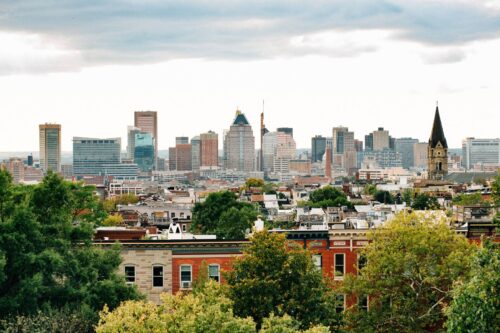
Maryland’s Opportunity to Lead on Fossil-Free Buildings
Maryland, a state well-known for its blue crabs, baseball, and diverse natural landscapes, has quietly crept into the national spotlight for another reason — as a leader on building decarbonization. The state is on the verge of joining a growing group of states, including Washington and New York, looking to equitably wean their buildings off fossil fuels.
The Maryland Building Energy Transition Plan, published in late 2021 by the state’s Commission on Climate Change, highlights a shift toward efficient, electric heating and a 60–95 percent reduction in gas use in buildings as the state moves toward its net-zero emissions goal by 2045. Through research, consultation, and public input, the report recommends clear policy outcomes to prepare for the shift — most of which have influenced bills recently introduced in the General Assembly.
During the recent legislative session, the Maryland General Assembly introduced several high-profile provisions to equitably move buildings away from direct fossil fuel combustion, including:
- a robust gas transition planning process,
- shifting toward electrification in the state’s energy efficiency program,
- all-electric new construction,
- a building energy performance standard for large buildings, and more.
The timing of these bills coincides with an earnest reminder that natural gas poses health and safety risks. In early March, a cut gas line in a Silver Spring apartment led to an explosion that injured 14 people.
Maryland’s Next Moves
On March 14, the state Senate passed Climate Solutions Now (SB 528), which requires the state to hit net-zero emissions by 2045, calls for millions of dollars for climate mitigation (40 percent of which must go to low-income communities and cannot be used for fossil fuels), implements a building energy performance standard requiring decreased on-site emissions, establishes a just transition and retraining working group, and more.
The following provisions being considered by the legislature are critical for climate, economy, and health in Maryland:
- Long-term gas transition planning: The proposed Comprehensive Climate Solutions Act (HB 708) includes language around planning for the transition away from gas. The bill would 1) require utilities to assess continued gas system investments in the face of a 50–100 percent decline in gas throughput to buildings and a shrinking customer base, 2) allow the state’s Public Service Commission to reject a plan that does not meet its criteria, 3) prioritize low- and middle-income households, 4) assess options for gas infrastructure decommissioning, and 5) explore alternative revenue sources for gas utilities. Maryland is not alone in valuing early planning. Ten jurisdictions, including New York, Minnesota, and Nevada, have initiated processes to evaluate the future of gas. Long-term transition planning by the Public Service Commission and utilities would ensure a more equitable and prosperous transition for Maryland.
- Increased role of fuel switching in the state’s EmPOWER energy efficiency program: EmPOWER Maryland brings energy efficiency equipment and installations to low- and moderate-income Marylanders at no cost. HB 708 introduces legislation that encourages the program to replace fossil fuel heating systems in homes with electrified appliances, like heat pumps. Expanded eligibility for fuel switching presents heating oil and propane heat customers, in particular, with an opportunity to save money, improve comfort, and reduce emissions by switching to clean, electric heat. Directing investments to home weatherization, beneficial electrification, and pre-electrification repairs can reduce gas demand, lower bills, and improve health and comfort — without locking households into 15-plus years of continued and increasingly expensive gas use.
- Building performance standard for large buildings: SB 528 contains a building energy performance standard calling for net-zero direct greenhouse gas emissions by 2040 (and a 35 percent reduction by 2035) for multifamily residential or commercial buildings larger than 25,000 square feet. The focus on direct greenhouse emissions reductions — primarily from on-site fossil fuel use — would drive electrification during asset replacement cycles in years to come.
- Electrification-preferred or electrification-ready new construction: While the Senate removed provisions for all-electric new construction, conversations remain active in the House. Electric-preferred or electric-ready new construction building codes, which require new homes to have the electrical wiring, circuitry, and capacity to one day become all-electric, could be considered by the House. The Building Energy Transition plan found all-electric new construction to be a cost-effective measure for consumers. Continuing to build out and expand fossil fuel infrastructure to new buildings, on the other hand, risks investing ratepayer dollars in new stranded assets and additional infrastructure maintenance costs. Many cities across the country have already committed to fully electrifying new construction, through base or building stretch codes.
Taking the Lead
The State’s Building Energy Transition Plan does not simply offer climate benefits but also significant public health benefits. An increasing body of research shows that emissions from gas, heating oil, and propane combustion in buildings negatively impacts indoor and outdoor air quality, putting vulnerable populations at risk and increasing pollution-related premature mortality.
On-site combustion of fossil fuels in buildings contributed 13 percent of Maryland’s emissions in 2017, and it will take a concerted effort to shrink this percentage down to zero. Maryland has done important work over the past year to review the most promising economic, technical, and equity pathways to achieving its climate goals in the decades ahead. Through its Building Energy Transition Plan and legislative action, Maryland has an opportunity to be an early leader in building decarbonization. Provisions already introduced or being considered in the General Assembly provide reasonable and appropriate first steps to advance this work in the years to come.